Chapter 11 Kubernetes core concepts
After the basic deployment in the previous chapter, the components of Kubernetes are not fully understood, especially the characteristics and location of each component are not very clear. Therefore, this chapter will explain the core concepts of each component in detail.
11.1 Kubernetes object
- Service network access: progress, Services
- Container management types: Deployment, ReplicaSet, ReplicationController, DaemonSet, StatefulSet
- Container storage types: Volume, Secret, ConfigMap, PersistentVolume
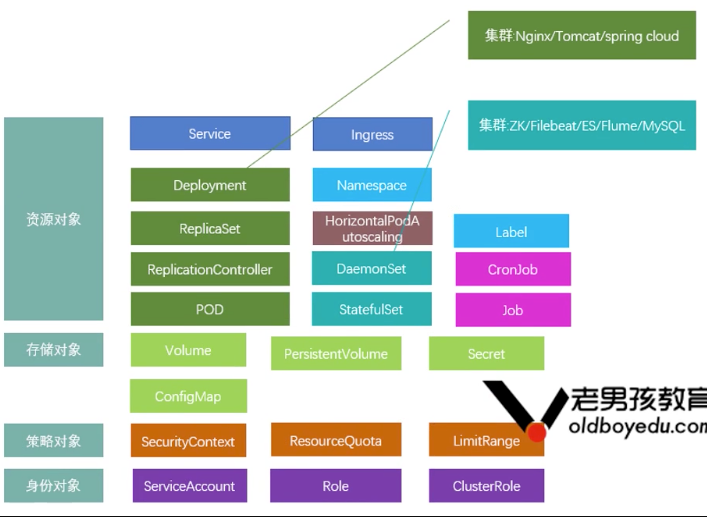
Logical hierarchy
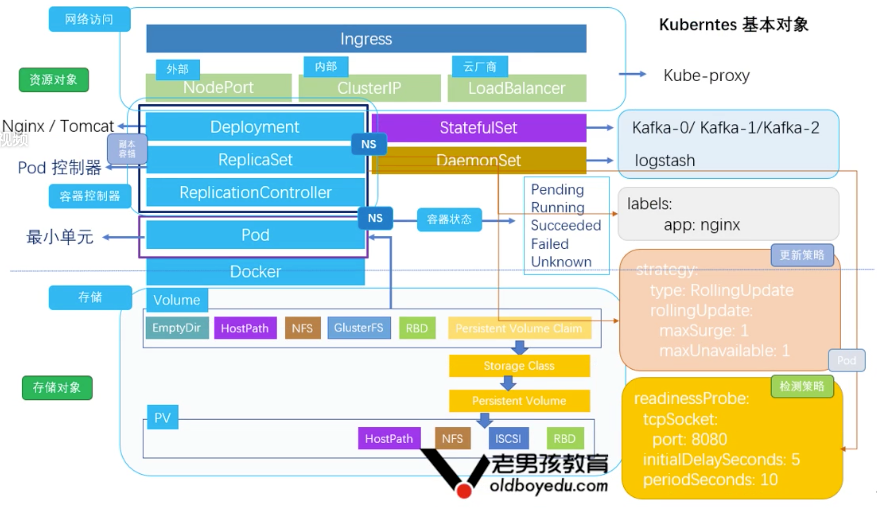
11.2 cluster resource management
11.2.0 Node
Node is the working node of kubernetes cluster, which can be either a physical machine or a virtual machine.
11.2.1 Namespace
A logical isolation technology that saves resources.
Namespace is similar to the concept of users in Linux system. By assigning objects within the system to different namespaces, it forms a logical distinction, so that different groups can be managed separately while sharing cluster resources.
The Name of the Kubernetes object under the same Namespace must be unique.
Namespace provides a scope for names. The name of a resource needs to be unique within a namespace, but cannot cross namespaces. Namespaces cannot be nested within another namespace, and each Kubernetes resource can only belong to one namespace.
By default, the Kubernetes cluster instantiates a default namespace default when configuring the cluster to store the default Pods, Services and Deployments collections used by the cluster.
Note: you do not need to use multiple namespaces to separate minor and different resources, such as different releases of the same project.
11.2.1.1 case: Namespace operation
Create NS
[root@master-1 ~]# kubectl create namespace ns-system
Create test-ns.yaml from the Yaml file
[root@master-1 test]# cat test-ns.yaml apiVersion: v1 kind: Namespace metadata: name: test-ns
View NS list
[root@master-1 ns]# kubectl apply -f test-ns.yaml namespace/test-ns created [root@master-1 ns]# kubectl get namespace NAME STATUS AGE default Active 4d2h kube-node-lease Active 4d2h kube-public Active 4d2h kube-system Active 4d2h kubernetes-dashboard Active 3d21h monitoring Active 3d6h test-ns Active 7s
View ns details
[root@master-1 ns]# kubectl describe namespace/test-ns
Name: test-ns
Labels: <none>
Annotations: kubectl.kubernetes.io/last-applied-configuration: {"apiVersion":"v1","kind":"Namespace","metadata":{"annotations":{},"name":"test-ns"}}
Status: Active
No resource quota.
No resource limits.
Relationship between NS and Service (10.0.0.0 / 8)
- When a Service is created, it creates the corresponding DNS record.
- The format of this record is < servicename >. < namespace name >. Svc.cluster.local, which means that if the container only uses < service name >, it will resolve to the local service to namespace (default).
- If you want to access across namespaces, you need to use a fully qualified domain name (FQDN).
#The name of dns resolution is svc (service name, not pod name) dnstools# nslookup nginx Server: 10.0.0.2 Address: 10.0.0.2#53 Name:nginx.default.svc.cluster.local Address: 10.0.0.55
For non default default, the full name nginx-n1.kube-system needs to be written
dnstools# nslookup nginx-n1 Server: 10.0.0.2 Address: 10.0 0.2#53 ** server can't find nginx-n1: NXDOMAIN dnstools# nslookup nginx-n1 Server: 10.0.0.2 Address: 10.0 0.2#53 #Solution (resolve to default space by default) dnstools# nslookup nginx-n1.kube-system.svc.cluster.local Server: 10.0.0.2 Address: 10.0 0.2#53 Name: nginx-n1.kube-system.svc.cluster.local Address: 10.0.0.196
11.2.2 Label
Label mechanism is an important design in Kubernetes. Through the association of objects (pod,service,node) through label, you can classify and select flexibly.
For a Pod, you need to set its own Label to identify it,
Label is a series of Key/value pairs, which are set in Pod – > metadata – > labels. The definition of label is arbitrary, but the label must be identifiable, such as setting the application name and version number of Pod. In addition, the label is not unique. In order to more accurately identify a Pod, multiple dimension labels should be set for the Pod. As follows:
- "release" : "stable", "release" : "canary"
- "environment" : "dev", "environment" : "uat", "environment" : "production"
- "partition" : "customerA", "partition" : "customerB"
11.2.2.1 case 1: setting container Label
In Job, Deployment, ReplicaSet and DaemonSet, the metadata.labels field is usually used in the container to add labels to objects, for example:
Configuration Label
[root@master-1 ingress]# cat traefik-deploy.yaml
apiVersion: apps/v1
kind: DaemonSet
metadata:
name: traefik-ingress-controller
labels:
app: traefik
View label
[root@master-1 ingress]# kubectl describe pod traefik-ingress-controller
Name: traefik-ingress-controller-4cn9t
Namespace: default
Priority: 0
Node: 192.168.91.21/192.168.91.21
Start Time: Sat, 18 Apr 2020 16:02:08 +0800
Labels: app=traefik
controller-revision-hash=846985d876
pod-template-generation=4
Interface view

11.2.2.2 case 2: setting Node Label
Set the label label of Node to IngressProxy=true
[root@master-1 ingress]# kubectl label nodes 192.168.31.7 IngressProxy=true
Check for success
[root@master-1 ~]# kubectl get nodes --show-labels NAME STATUS ROLES AGE VERSION LABELS 192.168.31.7 Ready <none> 4d1h v1.15.1 IngressProxy=true,beta.kubernetes.io/arch=amd64,beta.kubernetes.io/os=linux,kubernetes.io/arch=amd64,kubernetes.io/hostname=192.168.31.7,kubernetes.io/os=linux 192.168.31.8 Ready <none> 4d1h v1.15.1 IngressProxy=true,beta.kubernetes.io/arch=amd64,beta.kubernetes.io/os=linux,kubernetes.io/arch=amd64,kubernetes.io/hostname=192.168.31.8,kubernetes.io/os=linux [root@master-1 ~]# kubectl get nodes -l IngressProxy=true NAME STATUS ROLES AGE VERSION 192.168.31.7 Ready <none> 4d1h v1.15.1 192.168.31.8 Ready <none> 4d1h v1.15.1
[root@master-1 ~]# kubectl label nodes 192.168.31.7 isNode=true node/192.168.31.7 labeled [root@master-1 ~]# kubectl get nodes --show-labels NAME STATUS ROLES AGE VERSION LABELS 192.168.31.7 Ready <none> 4d1h v1.15.1 IngressProxy=true,beta.kubernetes.io/arch=amd64,beta.kubernetes.io/os=linux,isNode=true,kubernetes.io/arch=amd64,kubernetes.io/hostname=192.168.31.7,kubernetes.io/os=linux 192.168.31.8 Ready <none> 4d1h v1.15.1 IngressProxy=true,beta.kubernetes.io/arch=amd64,beta.kubernetes.io/os=linux,kubernetes.io/arch=amd64,kubernetes.io/hostname=192.168.31.8,kubernetes.io/os=linux [root@master-1 ~]# kubectl get nodes -l isNode=true NAME STATUS ROLES AGE VERSION 192.168.31.7 Ready <none> 4d1h v1.15.1
11.3 vessel controller Pod
11.3.1 Pod (container controller)
Pod is the smallest unit of Kubernetes' basic operation and the carrier of application operation.
The whole Kubernetes system is developed around Pod; For example, how to deploy and run pods, how to ensure the number of pods, how to access pods, etc.
You can think of a Pod as a wrapper for a single container, and Kubernetes manages the Pod directly, not the container.
11.3.1.1 case 1: create Nginx Pod
When the kubectl delete operation is invalid, you can try the following steps to troubleshoot the cause:
- Check whether the deployments task is created: kubectl get deployments
- Check if the replica controller is created ReplicationController: kubectl get rc
- Check if the replica set replicasets: kubectl get rs is created
If yes, execute kubectl delete deployment|rc|rs $name first, and then execute kubectl delete pod $pod_name can really achieve the purpose of deletion.
Delete the previous nginx pod
[root@master-1 ~]# kubectl delete deployment nginx-demo [root@master-1 ~]# kubectl delete rs nginx-demo-68749b58dc [root@master-1 ~]# kubectl delete rc nginx-demo-68749b58dc-xzk5c [root@master-1 ~]# kubectl delete pods nginx-demo [root@master-1 ~]# kubectl delete svc nginx-demo-svc
[root@master-1 nginx]# cat nginx.yaml
apiVersion: v1 #pod interface
kind: Pod #Controller name pod
metadata:
name: nginx #pod name
labels:
app: nginx #pod tag app=nginx
spec:
containers:
- name: nginx #Container name
image: nginx #Image name
ports:
- containerPort: 80 #Container port
hostPort: 3000 #node port
function
[root@master-1 nginx]# kubectl apply -f nginx.yaml pod/nginx created
View running status
[root@master-1 nginx]# kubectl describe pod nginx
Name: nginx
Namespace: default
Priority: 0
Node: 192.168.31.7/192.168.31.7
Start Time: Mon, 10 Aug 2020 17:55:55 +0800
Labels: app=nginx
Annotations: kubectl.kubernetes.io/last-applied-configuration:
{"apiVersion":"v1","kind":"Pod","metadata":{"annotations":{},"labels":{"app":"nginx"},"name":"nginx","namespace":"default"},"spec":{"conta...
Status: Pending
IP:
Containers:
nginx:
Container ID:
Image: nginx
Image ID:
Port: 80/TCP
Host Port: 3000/TCP
State: Waiting
Reason: ContainerCreating
Ready: False
Restart Count: 0
Environment: <none>
Mounts:
/var/run/secrets/kubernetes.io/serviceaccount from default-token-7rdlr (ro)
Conditions:
Type Status
Initialized True
Ready False
ContainersReady False
PodScheduled True
Volumes:
default-token-7rdlr:
Type: Secret (a volume populated by a Secret)
SecretName: default-token-7rdlr
Optional: false
QoS Class: BestEffort
Node-Selectors: <none>
Tolerations: node.kubernetes.io/not-ready:NoExecute for 300s
node.kubernetes.io/unreachable:NoExecute for 300s
Events:
Type Reason Age From Message
---- ------ ---- ---- -------
Normal Scheduled 10s default-scheduler Successfully assigned default/nginx to 192.168.31.7
Normal Pulling 9s kubelet, 192.168.31.7 Pulling image "nginx"
11.3.2 ReplicationController and ReplicaSet (container controller)
The ReplicationController is used to ensure that the number of replicas of the container application is always maintained at the user-defined number of replicas (number of containers), that is, if a container exits abnormally, a new Pod will be automatically created to replace it; If there are abnormally many containers, they will also be recycled automatically.
In the new version of Kubernetes, it is recommended to use ReplicaSet instead of ReplicationController. ReplicaSet is not fundamentally different from ReplicationController in name, and ReplicaSet supports collective (multi label selection) selector.
11.3.2.1 case 1: create ReplicationController
- Use the template.metadata.labels field to attach a Label to the Pod to be created, that is, app=nginx
- Specify which pods this RC manages through the spec.selector field
[root@master-1 nginx-rc]# cat nginx-rc.yaml
apiVersion: v1
kind: ReplicationController #Vessel controller RC
metadata:
name: nginx-rc #RC name
spec:
replicas: 1 #Number of copies 1
selector:
app: nginx-rc #Controller selection app = nginx RC (label)
template:
metadata:
labels:
app: nginx-rc #Label of template: app = nginx
spec:
containers:
- name: nginx-rc #Container name
image: nginx #Image name
ports:
- containerPort: 80 #Container port
Deploy RC
[root@master-1 nginx]# kubectl apply -f nginx-rc.yaml replicationcontroller/nginx-rc created
View status
[root@master-1 nginx]# kubectl get rc
NAME DESIRED CURRENT READY AGE
nginx-rc 1 1 1 94s
[root@master-1 nginx]# kubectl describe rc nginx-rc
Name: nginx-rc
Namespace: default
Selector: app=nginx-rc
Labels: app=nginx-rc
Annotations: kubectl.kubernetes.io/last-applied-configuration:
{"apiVersion":"v1","kind":"ReplicationController","metadata":{"annotations":{},"name":"nginx-rc","namespace":"default"},"spec":{"replicas"...
Replicas: 1 current / 1 desired
Pods Status: 1 Running / 0 Waiting / 0 Succeeded / 0 Failed
Pod Template:
Labels: app=nginx-rc
Containers:
nginx-rc:
Image: nginx
Port: 80/TCP
Host Port: 0/TCP
Environment: <none>
Mounts: <none>
Volumes: <none>
Events:
Type Reason Age From Message
---- ------ ---- ---- -------
Normal SuccessfulCreate 2m1s replication-controller Created pod: nginx-rc-2rf4q
Access test
[root@master-1 ~]# kubectl run -it --rm --restart=Never --image=infoblox/dnstools:latest dnstools dnstools# curl 172.17.98.13
11.3.4 adjust RC Pod quantity
[root@master-1 nginx]# kubectl get pod NAME READY STATUS RESTARTS AGE nfs-client-provisioner-6d6f7ff69f-bk95b 1/1 Running 1 3d7h nginx 1/1 Running 0 13m nginx-rc-2rf4q 1/1 Running 0 4m8s [root@master-1 nginx]# kubectl scale rc nginx-rc --replicas=3 replicationcontroller/nginx-rc scaled [root@master-1 nginx]# kubectl get pod NAME READY STATUS RESTARTS AGE nfs-client-provisioner-6d6f7ff69f-bk95b 1/1 Running 1 3d7h nginx 1/1 Running 0 15m nginx-rc-2rf4q 1/1 Running 0 5m17s nginx-rc-dvgqb 0/1 ContainerCreating 0 27s nginx-rc-gmddb 0/1 ContainerCreating 0 27s

[the external chain picture transfer fails. The source station may have an anti-theft chain mechanism. It is recommended to save the picture and upload it directly (img-5s7z2vRL-1634538453109)(assets/CA49DA8A169A40A7B3A598161165D374.png)]
pod does not support capacity expansion (command capacity expansion)
[root@master-1 nginx]# kubectl scale pod nginx --replicas=2 error: could not find proper group-version for scale subresource of /v1, Resource=pods: could not find scale subresource for /v1, Resource=pods in discovery information
pod does not support capacity expansion (yaml)
[root@master-1 nginx1]# cat nginx.yaml
apiVersion: v1
kind: Pod
metadata:
name: nginx #pod name
labels: #Label label
app: nginx #Define the label of pod: app = nginx
spec:
replicas: 2 # Number of containers
containers:
- name: nginx #Container name
image: nginx #Image name
ports:
- containerPort: 80 #Container port
hostPort: 3000 #node interface port
An error occurred. The interface does not support replicas
[root@master-1 nginx]# kubectl apply -f nginx.yaml error: error validating "nginx.yaml": error validating data: ValidationError(Pod.spec): unknown field "replicas" in io.k8s.api.core.v1.PodSpec; if you choose to ignore these errors, turn validation off with --validate=false
11.3.2.2 case 2: create ReplicaSet
- In addition to using matchLabels, the selector also supports collective operations.
- By modifying the value of. spec.replicas, the number of pods run by RS can be modified in real time.
- There is a problem downloading the image
apiVersion: apps/v1
kind: ReplicaSet
metadata:
name: frontend
labels:
app: guestbook
tier: frontend
spec:
replicas: 3
selector:
matchLabels:
tier: frontend
matchExpressions:
- {key: tier, operator: In, values: [frontend]}
template:
metadata:
labels: #Define multiple labels
app: guestbook
tier: frontend
spec:
containers:
- name: php-redis
image: gcr.io/google_samples/gb-frontend:v3
resources:
requests:
cpu: 100m
memory: 100Mi
env:
-name: GET_HOSTS_FROM
value: dns
ports:
-containerPort: 80
Check whether the startup is successful
[root@master-1 ~]# kubectl describe rs/frontend
11.3.3 Deployment
Deployment is also a core content of Kubernetes. Its main responsibility is to ensure the number and health of pod s. 90% of its functions are exactly the same as Replication Controller, which can be regarded as a new generation of Replication Controller. However, it has new features beyond Replication Controller:
- Deployment inherits all the functions of replication controller described above.
- In the process of upgrading or creating a container, you can view the detailed progress and status.
- When upgrading the pod image or related parameters, if there is a problem, you can use the rollback operation to rollback to the previous version or the specified version.
- Every Deployment operation can be saved (with operation records) for subsequent rollback
- Every pod upgrade can be suspended and started at any time (easy to control).
- There are many upgrade schemes for pod:
- Recreate: delete all existing pod s and recreate new ones;
- RollingUpdate: the strategy of rolling upgrade and step-by-step replacement. At the same time, it supports more additional parameters, such as setting the maximum number of unavailable pod s, minimum upgrade interval, etc.
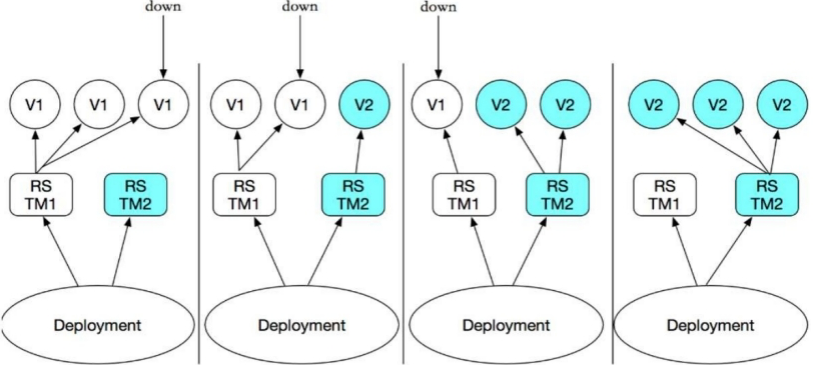
Create pod process by container controller
- Use Deployment to create a replicaset, which creates a pod in the background; Check the startup status of pod and whether it is successful.
- Declare the new status of the Pod by updating the PodTemplateSpec field of the Deployment. After that, a new ReplicaSet will be created,
Deployment will start a new ReplicaSet first according to the default update policy (25% of the number of replicas required for RollingUpdate, and the production recommended configuration is: 1) - If the new ReplicaSet fails to start (check port policy), the old ReplicaSet will continue to exist.
- If the expansion is successful, the old ReplicaSet will be cleaned up
System view Deployment
[root@master-1 ~]# kubectl get deployment NAME READY UP-TO-DATE AVAILABLE AGE nfs-client-provisioner 1/1 1 1 3d9h redis-tcp 1/1 1 1 96s
View Deployment details
[root@master-1 ~]# kubectl describe pod redis-tcp
Name: redis-tcp-5fcb54cd64-52p4d
Namespace: default
Priority: 0
Node: 192.168.31.7/192.168.31.7
Start Time: Mon, 10 Aug 2020 19:54:01 +0800
Labels: app=redis-tcp
pod-template-hash=5fcb54cd64
Annotations: <none>
Status: Running
IP: 172.17.14.13
Controlled By: ReplicaSet/redis-tcp-5fcb54cd64
Containers:
redis-tcp:
Container ID: docker://bafe30e1911b6a4ae80aca46cbd240d693e7ab7bf2ffb3e9c3a38f582712aacc
Image: redis
Image ID: docker-pullable://redis@sha256:09c33840ec47815dc0351f1eca3befe741d7105b3e95bc8fdb9a7e4985b9e1e5
Port: 6379/TCP
Host Port: 0/TCP
State: Running
Started: Mon, 10 Aug 2020 19:55:26 +0800
Ready: True
Restart Count: 0
Environment: <none>
Mounts:
/var/run/secrets/kubernetes.io/serviceaccount from default-token-7rdlr (ro)
Conditions:
Type Status
Initialized True
Ready True
ContainersReady True
PodScheduled True
Volumes:
default-token-7rdlr:
Type: Secret (a volume populated by a Secret)
SecretName: default-token-7rdlr
Optional: false
QoS Class: BestEffort
Node-Selectors: <none>
Tolerations: node.kubernetes.io/not-ready:NoExecute for 300s
node.kubernetes.io/unreachable:NoExecute for 300s
Events:
Type Reason Age From Message
---- ------ ---- ---- -------
Normal Pulling 118s kubelet, 192.168.31.7 Pulling image "redis"
Normal Scheduled 117s default-scheduler Successfully assigned default/redis-tcp-5fcb54cd64-52p4d to 192.168.31.7
Normal Pulled 33s kubelet, 192.168.31.7 Successfully pulled image "redis"
Normal Created 33s kubelet, 192.168.31.7 Created container redis-tcp
Normal Started 33s kubelet, 192.168.31.7 Started container redis-tcp


11.3.3 Pod upgrade strategy and detection mechanism
11.3.3.1 upgrade strategy:
strategy:
type: RollingUpdate #Default update policy Deployment
rollingUpdate:
maxSurge: 1 # The total number of pods can be up to 1 more than the required number of pods
maxUnavailable: 1 # Maximum number of 1 unavailable Pod during update
11.3.3.2 pod initiation and survival mechanism
pod ready detection (Deployment controller)
readinessProbe: #To determine whether the container has started normally
tcpSocket:
port: 8080 #Check port
initialDelaySeconds: 5 # kubelet sends the first ready probe five seconds after the container starts
periodSeconds: 10 #Survival detection is performed every 10 seconds
If the detection is successful, the Pod will be marked as ready, and kubelet will continue to run the detection every 10 seconds.
pod survival detection (Deployment controller)
livenessProbe: #Survival detection
tcpSocket:
port: 8080
initialDelaySeconds: 15 #kubelet performs the first survival probe 15 seconds after the container is started
periodSeconds: 20 #Survival detection is performed every 10 seconds
Like the ready probe, Kubelet attempts to connect to port 8080 of the container. If the survival probe fails, the container will be restarted.
11.3.3.3 case 1: create Deployment
[root@master-1 demo]# cat nginx-deployment.yaml
apiVersion: apps/v1 #Controller interface version
kind: Deployment #Controller type
metadata:
name: nginx-deployment # Deployment controller name
labels:
app: nginx-deployment # Deployment controller label
spec:
replicas: 3 # Number of Deployment replicas (number of containers)
selector:
matchLabels:
app: nginx-deployment #tag chooser
minReadySeconds: 1 #pod preparation time
strategy:
type: RollingUpdate #pod upgrade strategy
rollingUpdate:
maxSurge: 1 #Maximum 1 pod upgrade allowed
maxUnavailable: 1 #At most one pod is allowed to fail
template:
metadata:
labels:
app: nginx-deployment #Template label
spec:
containers:
- name: nginx-deployment #Container name
image: nginx:latest #Image name
ports:
- containerPort: 80 #Container port
readinessProbe: #Container readiness test
tcpSocket:
port: 80 #Detection port
initialDelaySeconds: 5 #5 seconds after container startup
periodSeconds: 10 #Detect every 10 seconds after container initialization
deploy
[root@master-1 deployment]# kubectl apply -f nginx-deployment.yaml deployment.apps/nginx-deployment created
Interface view update policy

View status
[root@master-1 deployment]# kubectl get pods -w NAME READY STATUS RESTARTS AGE nfs-client-provisioner-6d6f7ff69f-bk95b 1/1 Running 2 3d9h nginx 1/1 Running 1 140m nginx-deployment-8568b96ddb-f4fnc 1/1 Running 0 2m8s nginx-deployment-8568b96ddb-ljq9k 1/1 Running 0 2m8s nginx-deployment-8568b96ddb-qfgx7 1/1 Running 0 2m8s nginx-rc-2rf4q 1/1 Running 1 130m nginx-rc-dvgqb 1/1 Running 1 125m nginx-rc-gmddb 1/1 Running 1 125m redis-tcp-5fcb54cd64-52p4d 1/1 Running 0 22m
[root@master-1 deployment]# kubectl describe deployment.apps/nginx-deployment
Name: nginx-deployment
Namespace: default
CreationTimestamp: Mon, 10 Aug 2020 20:13:54 +0800
Labels: app=nginx-deployment
Annotations: deployment.kubernetes.io/revision: 1
kubectl.kubernetes.io/last-applied-configuration:
{"apiVersion":"apps/v1","kind":"Deployment","metadata":{"annotations":{},"labels":{"app":"nginx-deployment"},"name":"nginx-deployment","na...
Selector: app=nginx-deployment
Replicas: 3 desired | 3 updated | 3 total | 3 available | 0 unavailable
StrategyType: RollingUpdate
MinReadySeconds: 1
RollingUpdateStrategy: 1 max unavailable, 1 max surge
Pod Template:
Labels: app=nginx-deployment
Containers:
nginx-deployment:
Image: nginx:latest
Port: 80/TCP
Host Port: 0/TCP
Readiness: tcp-socket :80 delay=5s timeout=1s period=10s #success=1 #failure=3
Environment: <none>
Mounts: <none>
Volumes: <none>
Conditions:
Type Status Reason
---- ------ ------
Available True MinimumReplicasAvailable
Progressing True NewReplicaSetAvailable
OldReplicaSets: <none>
NewReplicaSet: nginx-deployment-8568b96ddb (3/3 replicas created)
Events:
Type Reason Age From Message
---- ------ ---- ---- -------
Normal ScalingReplicaSet 2m38s deployment-controller Scaled up replica set nginx-deployment-8568b96ddb to 3
Capacity expansion
scale supports container controller types deployment, replicaset, replication controller, and job
[root@master-1 deployment]# kubectl scale deployment nginx-deployment --replicas 10 deployment.extensions/nginx-deployment scaled
View Deployments

View RS controller

pod is being expanded and created
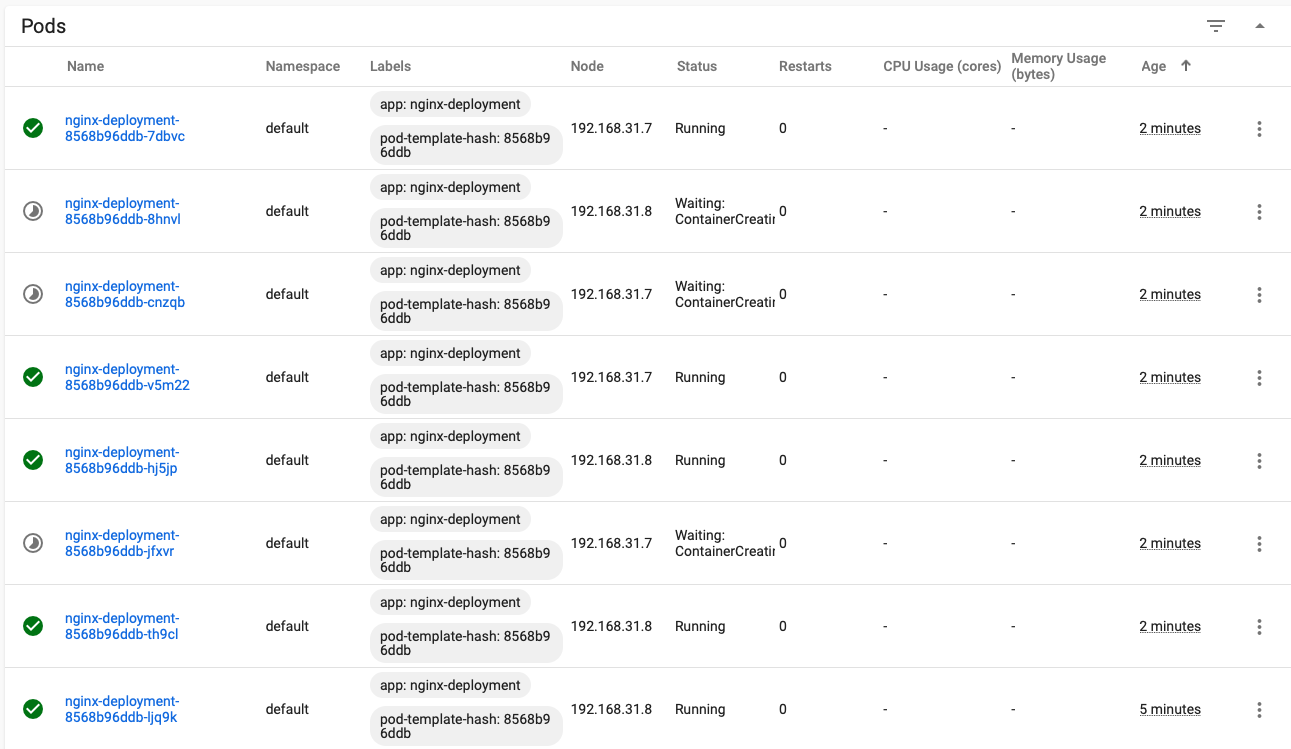
- Modify the configuration file and detect the update policy
- Change the image to a nonexistent image
- image: nginx111111:latest
[root@master-1 ~]# kubectl apply -f nginx-deployment.yaml
A new RS is created

Error in new RS associated pod

According to the update strategy, there will be two old pods. Because the new configuration file is applied, only three of the original 10 pods will be left, and one of them is being updated, so only two pods can be seen as normal

View the update process
[root@master-1 deployment]# kubectl describe deployment nginx-deployment
Name: nginx-deployment
Namespace: default
CreationTimestamp: Mon, 10 Aug 2020 20:13:54 +0800
Labels: app=nginx-deployment
Annotations: deployment.kubernetes.io/revision: 2
kubectl.kubernetes.io/last-applied-configuration:
{"apiVersion":"apps/v1","kind":"Deployment","metadata":{"annotations":{},"labels":{"app":"nginx-deployment"},"name":"nginx-deployment","na...
Selector: app=nginx-deployment
Replicas: 3 desired | 2 updated | 4 total | 2 available | 2 unavailable
StrategyType: RollingUpdate
MinReadySeconds: 1
RollingUpdateStrategy: 1 max unavailable, 1 max surge
Pod Template:
Labels: app=nginx-deployment
Containers:
nginx-deployment:
Image: nginx1111:latest
Port: 80/TCP
Host Port: 0/TCP
Readiness: tcp-socket :80 delay=5s timeout=1s period=10s #success=1 #failure=3
Environment: <none>
Mounts: <none>
Volumes: <none>
Conditions:
Type Status Reason
---- ------ ------
Available True MinimumReplicasAvailable
Progressing True ReplicaSetUpdated
OldReplicaSets: nginx-deployment-8568b96ddb (2/2 replicas created)
NewReplicaSet: nginx-deployment-84c85b9846 (2/2 replicas created)
Events:
Type Reason Age From Message
---- ------ ---- ---- -------
Normal ScalingReplicaSet 2m52s deployment-controller Scaled down replica set nginx-deployment-8568b96ddb to 3
Normal ScalingReplicaSet 2m52s deployment-controller Scaled up replica set nginx-deployment-84c85b9846 to 1
Normal ScalingReplicaSet 2m52s deployment-controller Scaled down replica set nginx-deployment-8568b96ddb to 2
Normal ScalingReplicaSet 2m52s deployment-controller Scaled up replica set nginx-deployment-84c85b9846 to 2
Delete nginx
[root@master-1 ~]# kubectl delete deployment.apps/nginx-deployment [root@master-1 deployment]# kubectl delete -f nginx-deployment.yaml deployment.apps "nginx-deployment" deleted
11.3.4 DaemonSet (container controller)
A DaemonSet object can ensure that the Pod it creates runs a copy on each (or specified Label) Node in the cluster.
- If a new Node is dynamically added to the cluster, the Pod in the DaemonSet will also be added to run on the newly added Node.
- Deleting a DaemonSet will also cascade delete all the pods it creates.
Usage scenario:
- Run the cluster storage daemon, such as glusterd and ceph on each Node.
- Run the log collection daemon on each Node, such as fluent D and logstash.

- Run the monitoring daemon on each Node, such as Prometheus Node Exporter

11.3.4.1 case 1: create a DaemonSet
apiVersion: extensions/v1beta1
kind: DaemonSet
metadata:
name: log-pilot
namespace: kube-system
labels:
k8s-app: log-pilot
kubernetes.io/cluster-service: "true"
spec:
template:
metadata:
labels:
k8s-app: log-es
kubernetes.io/cluster-service: "true"
version: v1.22
log-pilot

Each node runs a pod

11.3.5 StatefulSet
Kubernetes introduced PetSet as a new resource object from v1.4 and renamed it StatefulSet in v1.5. In essence, it can be regarded as a special type of Deployment/RC.
- Stateful set is suitable for stateful services;
- StatefulSet has a unique pod name identification, and supports persistent storage (the cluster needs to store data) and rolling update.
Assuming that the name of the StatefulSet running cluster is elasticsearch, the first pod is elasticsearch-0, the second pod is elasticsearch -1, and so on. It is precisely because of the orderly pod names that the component cluster can be (DNS needs to be installed).
11.3.5.1 case 1: stateful set establishes Elasticsearch cluster
apiVersion: apps/v1beta1
kind: StatefulSet
metadata:
name: elasticsearch
namespace: kube-system
labels:
kubernetes.io/cluster-service: "true"
spec:
replicas: 2
serviceName: "elasticsearch-service"
selector:
matchLabels:
app: es
template:
metadata:
labels:
app: es


11.3.6 basic operation of pod
- Create: kubectl create -f xxx.yaml
- Query list: kubectl get pod (resource type)
- Get pod details:
- kubectl describe pod nginx
- Get the node and IP address of the pod:
- kubectl get pods -o wide
- Monitoring pods status:
- kubectl get pods -w
- List all pod s:
- kubectl get pods -A
- Get pod according to tag (run = nginx):
- kubectl get pods -l app=nginx-deployment
- Enter pod:
- kubectl exec nginx-demo-68749b58dc-rr9rj -i -t bash -n default
- View pod content (non entry):
- kubectl exec nginx-deployment-8568b96ddb-psr74 -n default -i -t -- cat /etc/resolv.conf
- kubectl exec coredns-66db855d4d-26bvw -n kube-system -i -t -- cat /etc/resolv.conf
- Get pod details:
- Delete: kubectl delete pod yourPodName
- Update: kubectl apply /path/to/yourNewYaml.yaml
- Log: kubectl log -f yourPodName (container log can only be seen when it is displayed on the console)
- kubectl logs --tail=20 nginx
11.3.7 POD elastic expansion
Note: the types of elastic scaling supported by POD are deployment, replicaset, and replicationcontroller
Elastic scaling refers to providing resources in an elastic and scalable manner to adapt to load changes. Reflected in Kubernetes, it means that the number of copies of Pod can be dynamically adjusted according to the load.
Adjusting the number of copies of Pod is achieved by modifying the number of copies of Pod in RC. The example command is as follows:
#Expand the number of replicas of the Pod to 10 [root@master-1 ~]# kubectl scale replicationcontroller nginx-deployment --replicas=10
11.3.8 management mode of pod
11.3.9 pod status information
- Pending: the Pod has been accepted by the Kubernetes system, but one or more container images have not been created. The waiting time includes the time to schedule the Pod and the time to download the image through the network, which may take some time.
- Running: the Pod has been bound to a node, and all containers in the Pod have been created. At least one container is running, or is in a startup or restart state.
- Succeeded: all containers in the Pod are successfully terminated and will not be restarted.
- Failed: all containers in the Pod have been terminated, and at least one container has been terminated due to failure. That is, the container exits in a non-zero state or is terminated by the system.
- Unknown: the status of the Pod cannot be obtained for some reasons, usually because the communication with the host where the Pod is located fails.
11.3.9.1 check the operation status of pod
[root@master-1 job]# kubectl get pod NAME READY STATUS RESTARTS AGE demo-app-57756548d8-sltsg 1/1 Running 1 3d11h dnstools 1/1 Running 0 122m nfs-client-provisioner-5978c5f69c-k9lkb 1/1 Running 1 5d
1.3.9.2 POD restart strategy
When a container exits abnormally or health check fails, kubelet will perform corresponding operations according to the settings of restart policy. The restart policies include always, onfailure and never
- Always: when the container fails, kubelet will automatically restart the container;
- OnFailure: when the container terminates and the exit code is not 0, kubelet will automatically restart the container;
- Never: kubelet will not restart the container regardless of its running state;
Restart policy usage scenario
- Deployment, RC and daemon set: must be set to Always, and the container needs to be kept running.
- Job and CronJob: OnFailure or Never. Ensure that the container is not restarted after execution.
- kubelet: automatically restart the Pod when it fails. No matter what value the RestartPolicy is set, the Pod will not be health checked.
1.3.9.2.1 configure pod restart strategy
- RC controller and DeamonSet controller are recommended to be set to Always, and it is necessary to ensure the continuous operation of the container.
- Job: OnFailure or Never. Ensure that the container is not restarted after execution.
[root@linux-master1 ~]# vim nginx-deployment.yaml
apiVersion: apps/v1
kind: Deployment
metadata:
name: nginx-deployment
namespace: default
labels:
app: nginx
spec:
selector:
matchLabels:
app: nginx
replicas: 1
template:
metadata:
labels:
app: nginx
spec:
restartPolicy: Always #Container restart policy
containers:
- name: nginx
image: nginx:1.12
imagePullPolicy: IfNotPresent #Image pull strategy
ports:
- containerPort: 80
11.4 mirroring strategy
The default image pull strategy is "IfNotPresent". kubelet will not pull the image if the image already exists.
- If you Always want to pull images, you must set the pull policy to "Always" or set the image label to ": latest".
- If the label of the image is not specified, it will be assumed to be ": latest", and the pull policy is "Always"
In the production environment, when running applications (micro services), it is recommended to set it to Always
Note that when pulling the self built private warehouse image, you need to create a Secret to pull the image. There are three download strategies in kubernetes:
- Always: download the latest image every time. This is recommended for microservices
- Never: only use local images and never download them. Single node
- IfNotPresent: download the image only if it is not available locally. This is recommended for open source third-party applications
11.4.1 case 1: configuring the image pull strategy
[root@linux-master1 ~]# vim nginx-deployment.yaml
apiVersion: apps/v1
kind: Deployment
metadata:
name: nginx-deployment
namespace: default
labels:
app: nginx-deployment
spec:
selector:
matchLabels:
app: nginx-deployment
replicas: 1
template:
metadata:
labels:
app: nginx-deployment
spec:
restartPolicy: Always
containers:
- name: nginx-deployment
image: nginx:1.12
imagePullPolicy: IfNotPresent
ports:
- containerPort: 80
11.5 scheduled tasks
11.5.1 Job
Job is responsible for batch tasks, that is, tasks that are executed only once. It ensures that one or more pods of batch tasks are completed successfully.
Usage scenario: clean up data and synchronize data
11.5.1.1 case 1: Job
The Job configuration file contains only one pod, 2000 digits after the decimal point of the output PI, and the running time is about 10s
[root@master-1 test]# kubectl create -f job.yaml
apiVersion: batch/v1
kind: Job
metadata:
name: pi
spec:
template:
spec:
containers:
- name: pi
image: perl
command: ["perl", "-Mbignum=bpi", "-wle", "print bpi(2000)"]
restartPolicy: Never
backoffLimit: 4
Note: the perl image is about 880M and needs to be downloaded to the node node in advance
[root@node-1 ~]# docker load < perl.tar 461719022993: Loading layer [==================================================>] 119.2MB/119.2MB f1d420c2af1a: Loading layer [==================================================>] 17.11MB/17.11MB a3c1026c6bcc: Loading layer [==================================================>] 17.85MB/17.85MB d35c5bda4793: Loading layer [==================================================>] 149.9MB/149.9MB 46829331b1e4: Loading layer [==================================================>] 520.3MB/520.3MB 28c01f06325c: Loading layer [==================================================>] 3.584kB/3.584kB 416facee2664: Loading layer [==================================================>] 55.49MB/55.49MB Loaded image ID: sha256:aebad195b013823cf83716d32039e016f7fa4e6acbd5d1eca2e494b42c85d2fa
function
[root@master-1 job]# kubectl apply -f job.yaml job.batch/pi created
View task
[root@master-1 job]# kubectl describe jobs/pi
Name: pi
Namespace: default
Selector: controller-uid=73adcf03-0cf7-46cb-b583-ec7a2ce9f8e5
Labels: controller-uid=73adcf03-0cf7-46cb-b583-ec7a2ce9f8e5
job-name=pi
Annotations: kubectl.kubernetes.io/last-applied-configuration:
{"apiVersion":"batch/v1","kind":"Job","metadata":{"annotations":{},"name":"pi","namespace":"default"},"spec":{"backoffLimit":4,"template":...
Parallelism: 1
Completions: 1
Start Time: Mon, 10 Aug 2020 23:03:16 +0800
Pods Statuses: 1 Running / 0 Succeeded / 0 Failed
Pod Template:
Labels: controller-uid=73adcf03-0cf7-46cb-b583-ec7a2ce9f8e5
job-name=pi
Containers:
pi:
Image: perl
Port: <none>
Host Port: <none>
Command:
perl
-Mbignum=bpi
-wle
print bpi(2000)
Environment: <none>
Mounts: <none>
Volumes: <none>
Events:
Type Reason Age From Message
---- ------ ---- ---- -------
Normal SuccessfulCreate 14s job-controller Created pod: pi-xcv2b
Get job
[root@master-1 test]# pods=$(kubectl get pods \
--selector=job-name=pi --output=jsonpath={.items..metadata.name})
[root@master-1 ~]# echo $pods
pi-xcv2b

Get results
[root@master-1 job]# kubectl get pods | grep $pods pi-t596w 0/1 Completed 0 3m29s [root@master-1 job]# kubectl logs $pods 3.1415926535897932384626433832795028841971693993751058209749445923078164062 862089986280348253421170679821480865132823066470938446095505822317253594081 28481117450284102701938521105559644622948954930381964428810975665933446128
The status of the container is Completed
[root@master-1 ~]# kubectl get pods | grep $pods pi-xcv2b 0/1 Completed 0 10m
View results
[root@master-1 ~]# kubectl log $pods log is DEPRECATED and will be removed in a future version. Use logs instead. 3.1415926535897932384626433832795028841971693993751058209749445923078164062862089986280348253421170679821480865132823066470938446095505822317253594081284811174502841027019385211055596446229489549303819644288109756659334461284756482337867831652712019091456485669234603486104543266482133936072602491412737245870066063155881748815209209628292540917153643678925903600113305305488204665213841469519415116094330572703657595919530921861173819326117931051185480744623799627495673518857527248912279381830119491298336733624406566430860213949463952247371907021798609437027705392171762931767523846748184676694051320005681271452635608277857713427577896091736371787214684409012249534301465495853710507922796892589235420199561121290219608640344181598136297747713099605187072113499999983729780499510597317328160963185950244594553469083026425223082533446850352619311881710100031378387528865875332083814206171776691473035982534904287554687311595628638823537875937519577818577805321712268066130019278766111959092164201989380952572010654858632788659361533818279682303019520353018529689957736225994138912497217752834791315155748572424541506959508295331168617278558890750983817546374649393192550604009277016711390098488240128583616035637076601047101819429555961989467678374494482553797747268471040475346462080466842590694912933136770289891521047521620569660240580381501935112533824300355876402474964732639141992726042699227967823547816360093417216412199245863150302861829745557067498385054945885869269956909272107975093029553211653449872027559602364806654991198818347977535663698074265425278625518184175746728909777727938000816470600161452491921732172147723501414419735685481613611573525521334757418494684385233239073941433345477624168625189835694855620992192221842725502542568876717904946016534668049886272327917860857843838279679766814541009538837863609506800642251252051173929848960841284886269456042419652850222106611863067442786220391949450471237137869609563643719172874677646575739624138908658326459958133904780275901
11.5.2 CronJob
CronJob is used to manage time-based jobs, namely:
- Run the Job once at a given point in time
- Run periodically at a given point in time
- Basic format of Crontab
- < minute > < hour > < day > < month > < week > < command >
- Minute values range from 0 to 59
- Hour values range from 0 to 23
- Daily values range from 1 to 31
- Monthly values range from 1 to 12
- Week values range from 0 to 6, where 0 represents Sunday
Multiple times can be separated by commas, ranges can be given by hyphens, and * can be used as wildcards. Spaces are used to separate fields.
11.5.2.1 case 1: create scheduled tasks # and regularly clean up data
echo "Hello from the Kubernetes cluster" every minute
[root@master-1 test]#cat cronjob.yaml
apiVersion: batch/v1beta1
kind: CronJob
metadata:
name: hello
spec:
schedule: "*/1 * * * *"
jobTemplate:
spec:
template:
spec:
containers:
- name: hello
image: busybox
args:
- /bin/sh
- -c
- date; echo Hello from the Kubernetes cluster
restartPolicy: OnFailure
Create task
[root@master-1 cronjob]# kubectl apply -f cronjob.yaml cronjob.batch/hello created

Get task list
[root@master-1 cronjob]# kubectl get cronjob NAME SCHEDULE SUSPEND ACTIVE LAST SCHEDULE AGE hello */1 * * * * False 1 34s 46s
Get task
[root@master-1 cronjob]# kubectl get jobs NAME COMPLETIONS DURATION AGE hello-1597072680 0/1 37s 37s pi 1/1 2m38s 15m
Get job
[root@master-1 job]# pods=$(kubectl get pods --selector=job-name=hello-1597072680 --output=jsonpath={.items..metadata.name})
[root@master-1 cronjob]# echo $pods
hello-1597072680-rc7hx
Get results
[root@master-1 cronjob]# kubectl logs $pods Mon Aug 10 15:19:27 UTC 2020 Hello from the Kubernetes cluster
View tasks through the interface
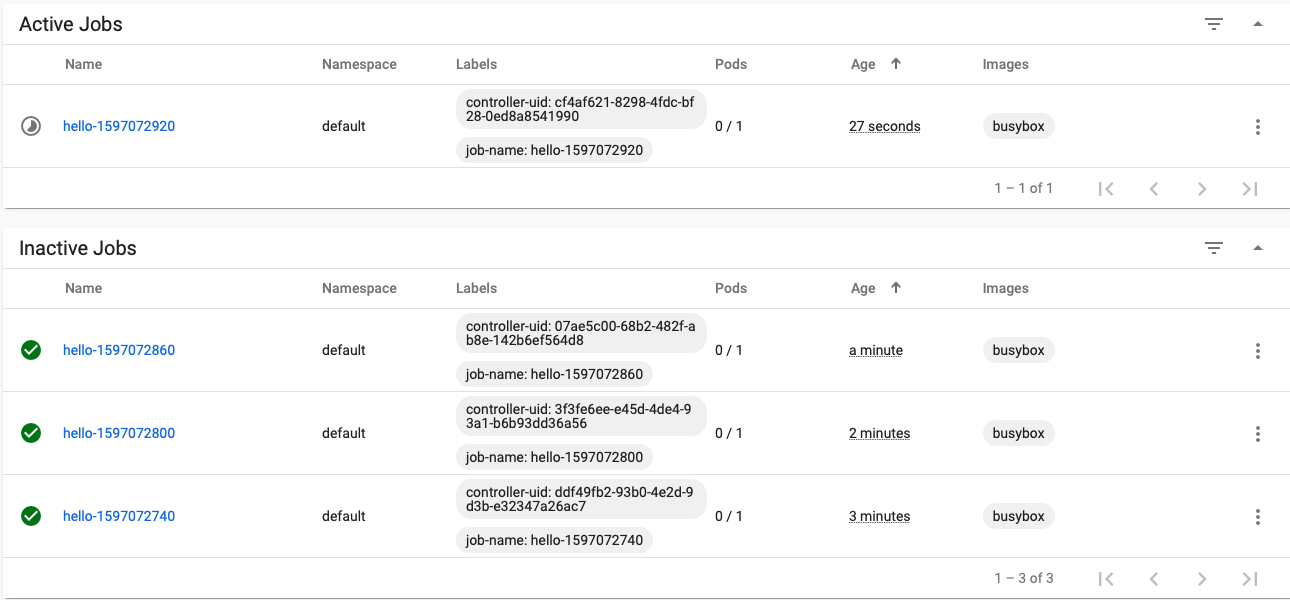
Results of scheduled task output

Delete Cron Job
[root@master-1 cronjob]# kubectl delete -f cronjob.yaml cronjob.batch "hello" deleted
11.6 service discovery
11.6.1 Service
This Service cannot be translated directly. In kubernetes, the concept of Service appears in order to better locate each pod or each group of POD (Label label label).
Because we know that the IP address of the POD changes after each restart or container redeployment, and the IP address of the container cannot be fixed, so we need Service to locate the POD.
11.6.1.1 case 1: define the Service of the Service
Access the application through the Nodeport port of the node
[root@master-1 java]# cat provider-passport-service.yaml
apiVersion: v1
kind: Service
metadata:
name: passport-svc #Service name
spec:
type: NodePort
ports:
- port: 8081 #Service port type
targetPort: 8081 #Container port
protocol: TCP #Port protocol
selector: #Select according to Label
app: passport
11.6.2 Service network agent mode
When users access the Service through the Service, they actually access the pod Service through the Kube proxy on the node node. The Kube proxy has the following working modes:
- Iptables (default mode),
- IPVS mode,
- userspace
In Kubernetes v1.2, the iptables mode of Kube proxy becomes the default. Kubernetes v1.8 adds the ipvs proxy mode.
Iptables mode
- The Node client directly accesses the ServiceIP, and Linux matches according to the Iptables protocol stack rules and policies.
- ServiceIP directly accesses the Backend Pod according to the tag.
IPVS proxy mode
IPVS is a component of LVS, which provides a four layer load balancer with high performance and high reliability. IPVS is the abbreviation of IP Virtual Server.
- IPVS is built on netfilter. As a part of Linux kernel, it realizes load balancing from the transport layer.
- IPVS can directly forward Services based TCP and UDP to real servers.
- IPVS can directly build a VIPs and forward the request to the backend Pod through the load balancing algorithm.
Load balancing algorithms supported by IPVS:
- rr: polling
- lc: minimum number of connections
- dh: destination address hash
- sh: source address hash
- sed: minimum expected delay
- nq: no queue waiting
11.6.2.1 case 1: Node enables IPVS
be careful:
- To run Kube proxy in IPVS mode, IPVS Linux must be made available on the node before starting Kube proxy.
- When Kube proxy starts in IPVS proxy mode, it verifies that the IPVS kernel module is available. If the IPVS kernel module is not detected, Kube proxy will return to running in iptables proxy mode.
Install ipvsadm, conntrack
[root@master-1 java]# yum -y install ipvsadm conntrack-tools
Load ipvs module
[root@master-1 java]# cat > /etc/sysconfig/modules/ipvs.modules <<EOF modprobe -- ip_vs modprobe -- ip_vs_rr modprobe -- ip_vs_wrr modprobe -- ip_vs_sh modprobe -- nf_conntrack_ipv4 EOF
View kernel module loading
[root@master-1 java]# cat >>/etc/sysctl.conf <<EOF net.ipv4.ip_forward = 1 net.bridge.bridge-nf-call-ip6tables = 1 net.bridge.bridge-nf-call-iptables = 1 EOF
take effect
[root@master-1 ipvs]# sysctl -p net.ipv4.ip_forward = 1 net.bridge.bridge-nf-call-ip6tables = 1 net.bridge.bridge-nf-call-iptables = 1
Modify Kube proxy configuration file
Add configuration
[root@node-1 ~]# cat /etc/kubernetes/cfg/kube-proxy --masquerade-all=true #Ensure that the reverse flow passes through --feature-gates=SupportIPVSProxyMode=true #Open support ipvs mode --proxy-mode=ipvs # Kube proxy final configuration --ipvs-scheduler=rr #Specify the proxy mode as ipvs
Select polling scheduling as the scheduling method
[root@node-1 ~]# cat /etc/kubernetes/cfg/kube-proxy KUBE_PROXY_OPTS="--logtostderr=true \ --v=4 --metrics-bind-address=0.0.0.0 \ --hostname-override=192.168.91.146 \ --masquerade-all=true \ --feature-gates=SupportIPVSProxyMode=true \ --proxy-mode=ipvs \ --ipvs-scheduler=rr \ --cluster-cidr=10.0.0.0/24 \ --kubeconfig=/etc/kubernetes/cfg/kube-proxy.kubeconfig"
View forwarding list and IP address
[root@node-1 ~]# ipvsadm -L -n | grep 8080
TCP 10.0.0.136:8080 rr
-> 172.17.25.2:8080 Masq 1 0 0
-> 172.17.67.9:8080 Masq 1 0 0
TCP 10.0.0.220:8080 rr
-> 172.17.25.7:8080 Masq 1 0 0
View IP
[root@node-1 ~]# ip a | grep 136
inet 10.0.0.136/32 brd 10.0.0.136 scope global kube-ipvs0
11.6.2.2 case 2: accessing services through IPVS
Get the pod address of the node
[root@master-1 ~]# kubectl get pod -A -o wide | grep 146 default demo-app-57756548d8-sltsg 1/1 Running 1 3d9h 172.17.25.7 192.168.91.146 <none> <none>
Get svc address of node 146
[root@master-1 ~]# kubectl get svc NAME TYPE CLUSTER-IP EXTERNAL-IP PORT(S) AGE demo-app ClusterIP 10.0.0.220 <none> 8080/TCP 3d9h
Access SVC of 146 nodes
dnstools# curl 10.0.0.220:8080 Hello! My name is demo-app-57756548d8-sltsg. I have served 202 requests so far.
Note: if a nodeport port is found on a node whose ipvs mode has been modified, you need to use iptables -F to clear the iptables table, or use curl to access it directly on the machine
11.6.3 Service type
- ClusterIP: expose the service through the internal IP of the cluster. Select this value. The service can only be accessed within the cluster. This is also the default ServiceType.
- NodePort: expose the service through the IP and static port (NodePort) on each Node. The NodePort service will be routed to the ClusterIP service, which will be automatically created. A NodePort service can be accessed from outside the cluster through the request:.
- LoadBalancer: using the load balancer of the cloud provider, you can expose services to the outside. External load balancers can route to NodePort services and ClusterIP services.
11.6.4 Service port type
- Port: the port of the service
- targetport: pod is the port of the container
- nodeport: the port of the host where the container is located (in essence, it is also exposed to the host through the service)
11.6.5 Service access mode
The virtual IP of Service is an internal network virtualized by Kubernetes, which cannot be addressed externally. However, some services need to be accessed externally, such as the web front end. At this time, you need to add a layer of network forwarding, that is, forwarding from the external network to the internal network.
Kubernetes provides three ways to access services: NodePort, LoadBalancer and Ingress.
Access mode diagram:

- NodePort, Kubernetes will expose a port on each Node: NodePort. The external network can access the back-end Service through [NodeIP]:[NodePort].
- LoadBalancer: on the basis of NodePort, Kubernetes can request the underlying cloud platform to create a load balancer and use each Node as the back end for service distribution. This mode requires the support of the underlying cloud platform (such as GCE).
- Ingress is an HTTP routing and forwarding mechanism, which is composed of Ingress Controller and HTTP proxy server. The Ingress Controller monitors the Kubernetes API in real time and updates the forwarding rules of the HTTP proxy server in real time. HTTP proxy servers include GCE load balancer, HaProxy, Nginx and other open source solutions.
- It is essentially a reverse proxy.
11.7 DNS
The DNS server monitors the Kubernetes API that creates new services to create a set of DNS records for each Service. If the DNS of the whole cluster is enabled all the time, all pods should be able to self resolve the name of the Service.
For example, there is a Service named "my Service", which creates a DNS record for "my Service. My ns" in the Namespace named "myns" in the Kubernetes cluster. The Pod in the Namespace named "myns" should be able to find "my Service" simply by name query.
11.7.1 case 1: accessing the Service through the Service name
Get Service name
[root@master-1 job]# kubectl get svc NAME TYPE CLUSTER-IP EXTERNAL-IP PORT(S) AGE demo-app ClusterIP 10.0.0.220 <none> 8080/TCP 3d11h kubernetes ClusterIP 10.0.0.1 <none> 443/TCP 9d
Access services
Correct format of service access: SERVICE_NAME.NS
[root@master-1 job]# kubectl run -it --rm --restart=Never --image=infoblox/dnstools:latest dnstools dnstools# curl demo-app.default:8080 Hello! My name is demo-app-57756548d8-sltsg. I have served 2279 requests so far.
Note: the Service will not be modified without modification; The cluster ip will be modified every time the Service is rebuilt. Therefore, it is recommended to use service name to connect to internal services. This is why DNS needs to be installed.
11.8 storage - Secret
Secret solves the configuration problem of sensitive data such as password, token and key without exposing these sensitive data to the image or Pod Spec. Secret can be used as Volume or environment variable.
There are three types of Secret:
- Service Account: used to access the Kubernetes API, which is automatically created by Kubernetes and automatically mounted in the / run/secrets/kubernetes.io/serviceaccount directory of Pod;
- Opaque: Secret in base64 encoding format, which is used to store passwords, keys, etc;
- kubernetes.io/dockerconfigjson: used to store the authentication information of the private docker registry.
11.8.1 case 1: import Docker Registry authentication information
In Kubernetes, you need to import the login information of Docker private image warehouse to pull images from the private warehouse,
The login information is stored using Secret encryption.
- Create secret key
#Create a secret (pay attention to resolving docker server (hosts)) [root@master-1 ~]# kubectl create secret docker-registry registry-secret --docker-server=reg.abc.com --docker-username=user --docker-password=Aa123456 --docker-email=user@abc.com secret/registry-secret created
- Download key
[root@master-1 ~]# kubectl get secret registry-secret -o yaml apiVersion: v1 data: .dockerconfigjson: eyJhdXRocyI6eyJyZWcuYWJjLmNvbSI6eyJ1c2VybmFtZSI6InVzZXIiLCJwYXNzd29yZCI6IkFhMTIzNDU2IiwiZW1haWwiOiJ1c2VyQGFiYy5jb20iLCJhdXRoIjoiZFhObGNqcEJZVEV5TXpRMU5nPT0ifX19 kind: Secret metadata: creationTimestamp: "2020-08-11T00:55:20Z" name: registry-secret namespace: default resourceVersion: "142965" selfLink: /api/v1/namespaces/default/secrets/registry-secret uid: bf406ed7-a8de-41d7-ab2a-1e1791023162 type: kubernetes.io/dockerconfigjson
- Modify to the format to be imported. apiVersion: v1
kind: Secret metadata: name: regis-secre namespace: default data: .dockerconfigjson: eyJhdXRocyI6eyJyZWcuYWJjLmNvbSI6eyJ1c2VybmFtZSI6InVzZXIiLCJwYXNzd29yZCI6IkFhMTIzNDU2IiwiZW 1haWwiOiJ1c2VyQGFiYy5jb20iLCJhdXRoIjoiZFhObGNqcEJZVEV5TXpRMU5nPT0ifX19 type: kubernetes.io/dockerconfigjson
- kubectl create -f registry-secret.yaml
[root@master-1 ~]# cat registry-secret.yaml apiVersion: v1 kind: Secret metadata: name: regsecret namespace: default data: .dockerconfigjson:eyJhdXRocyI6eyJyZXBvLmhvc3RzY2MuY29tIjp7InVzZXJuYW1lIjoidXNlciIsInBhc3N3b3JkIjoiQWExMjM0NTY3OCIsImVtYWlsIjoidXNlckBhYmMuY29tIiwiYX
11.9 role based access control - RBAC
Role based access control (RBAC) is a method to adjust and control access to computer or network resources based on the role of users in the enterprise.
- RBAC uses rbac.authorization.k8s.io API Group to realize authorization decision, and allows administrators to dynamically configure policies through Kubernetes API
- To enable RBAC, you need to add the parameter – authorizationmode=RBAC in the apiserver configuration file
11.9.1 RABC operable resource list
- Pods: container
- ConfigMaps: Configuration
- Deployments: container controller
- Nodes: nodes
- Secrets: credentials
- Namespaces: namespace
11.9.2 resource list operable permission list
Create,get,delete,list,update,edit,watch,exec
Relationship between resource list and permission:
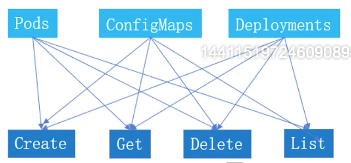
11.9.3 other objects in RBAC
- Rule: a rule is a set of operations belonging to different API Group resources;
- Role and ClusterRole: role and cluster role. These two objects contain the above Rules elements,
- The difference is,
- In Role, the defined rules only apply to a single namespace, that is, those associated with the namespace,
- The ClusterRole is cluster wide, so the defined rules are not constrained by the namespace.
- Subject: subject, which corresponds to the object trying to operate in the cluster. Three types of subject resources are defined in the cluster:
- User Account: the user is managed by an external independent service. The administrator allocates the private key. The user can use KeyStone or Google account, or even a file list of user name and password. For user management, there is no associated resource object in the cluster, so users cannot manage through the API in the cluster;
- Group: group, which is used to associate multiple accounts. There are some default groups in the cluster, such as clusteradmin;
- Service Account: Service Account, some user accounts managed through Kubernetes API and associated with namespace. It is applicable to applications running inside the cluster. Permission authentication needs to be completed through API. Therefore, ServiceAccount is required for permission operations inside the cluster
- RoleBinding and ClusterRoleBinding: Role binding and cluster Role binding. In short, it is the process of binding the declared Subject to our Role (binding the operation permission to a user),
- The difference between the two is also the difference in the scope of action:
- RoleBinding will only affect the resource operation permissions under the current namespace,
- ClusterRoleBinding affects all namespace s.
11.9.3.1 authorization role binding diagram
Internal authentication of Service Account cluster
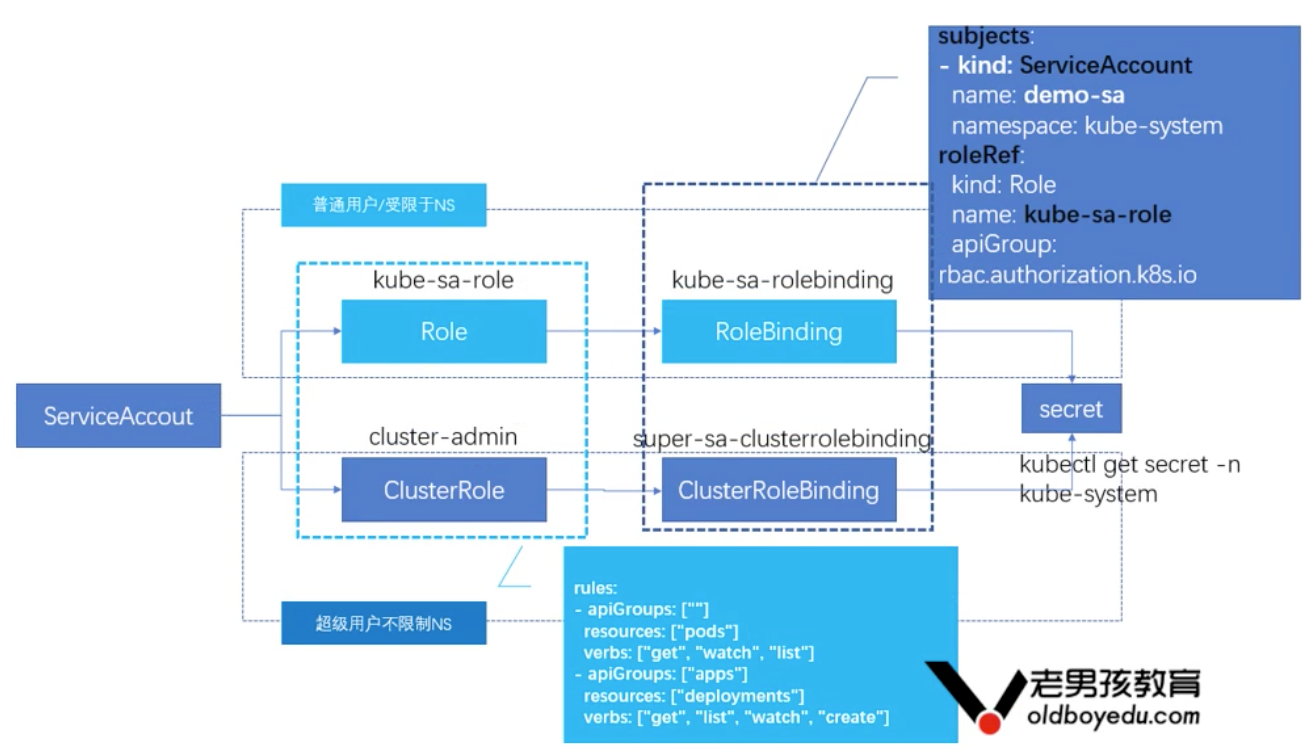
11.9.4 case 1: create a user to log in to the Dashboard
Create a user who logs in to the dashboard and can only operate pods and deployments under the Kube system namespace, so you need to create a ServiceAccount object
Create SA object
[root@master-1 ~]# kubectl create sa demo-sa -n kube-system serviceaccount/demo-sa created
Create role Kube role
[root@master-1 ~]# cat kube-sa-role.yaml
apiVersion: rbac.authorization.k8s.io/v1
kind: Role
metadata:
name: kube-sa-role
namespace: kube-system
rules:
- apiGroups: [""] #The apiGroup corresponding to the resource pods could not be found
resources: ["pods"] #Actionable resources
verbs: ["get", "watch", "list"] #List of operations on resources
- apiGroups: ["apps"]
resources: ["deployments"]
verbs: ["get", "list", "watch", "create", "update", "patch", "delete"]
Common apiGroups list: https://kubernetes.io/docs/reference/generated/kubernetes-api/v1.15/
[root@master-1 ~]# cat kube-sa-rolebinding.yaml
kind: RoleBinding
apiVersion: rbac.authorization.k8s.io/v1
metadata:
name: kube-sa-rolebinding
namespace: kube-system
subjects:
- kind: ServiceAccount
name: demo-sa
namespace: kube-system
roleRef:
kind: Role
name: kube-sa-role
apiGroup: rbac.authorization.k8s.io
ServiceAccount will generate a Secret object and map it. This Secret contains a token. If the dashboard also belongs to Kube system, this token can be used to log in to the dashboard
[root@master-1 rabc]# kubectl apply -f kube-sa-role.yaml role.rbac.authorization.k8s.io/kube-sa-role created [root@master-1 rabc]# kubectl apply -f kube-sa-rolebinding.yaml rolebinding.rbac.authorization.k8s.io/kube-sa-rolebinding created
Get token
[root@master-1 rabc]# kubectl get secret -n kube-system |grep demo-sa demo-sa-token-njvtq kubernetes.io/service-account-token 3 2m41s
Get base64
[root@master-1 rabc]# kubectl get secret demo-sa-token-njvtq -o jsonpath={.data.token} -n kube-system |base64 -d
eyJhbGciOiJSUzI1NiIsImtpZCI6IiJ9.eyJpc3MiOiJrdWJlcm5ldGVzL3NlcnZpY2VhY2NvdW50Iiwia3ViZXJuZXRlcy5pby9zZXJ2aWNlYWNjb3VudC9uYW1lc3BhY2UiOiJrdWJlLXN5c3RlbSIsImt1YmVybmV0ZXMuaW8vc2VydmljZWFjY291bnQvc2VjcmV0Lm5hbWUiOiJkZW1vLXNhLXRva2VuLW5qdnRxIiwia3ViZXJuZXRlcy5pby9zZXJ2aWNlYWNjb3VudC9zZXJ2aWNlLWFjY291bnQubmFtZSI6ImRlbW8tc2EiLCJrdWJlcm5ldGVzLmlvL3NlcnZpY2VhY2NvdW50L3NlcnZpY2UtYWNjb3VudC51aWQiOiI5YmI2ZTFiMi1iMWU5LTRhZjUtYmMyYy02ODNkNjc2YmQ1ODMiLCJzdWIiOiJzeXN0ZW06c2VydmljZWFjY291bnQ6a3ViZS1zeXN0ZW06ZGVtby1zYSJ9.MCgiXFjxbYEC2HqtBJsKpS-5EWCmw2kULsOZqIYLwxFXpR8rAPzpjzU5WuIDNCguebxOXK_3VnIY-5kLI5TlvyImvM8KEOZkn2JpmJp3EgPzOzypIoqADDCO9rxRTTzGhxS0O1oskuGJu2IZaIGZhrk6GdJ-dc1Mc94wOaqaLHDQXLbZSJmSQvFliDRxYvJZ4fVxztICAUjnTvUMrXgf6RT6nqR6ZFt7m46gLBoxrOiOVHJzBFmqlIXYqk2l-vwaufTS_Vw5oKcEXNItl3g9SydG5Ezp1fb14mnN2YnM_XsCJxRzSOU2H_GPEe-3sgiBbfzdh1HrhBAORUCSqIxT5g
Log in to dashbosh and enter the token generated above

Enter the Kube system namespace
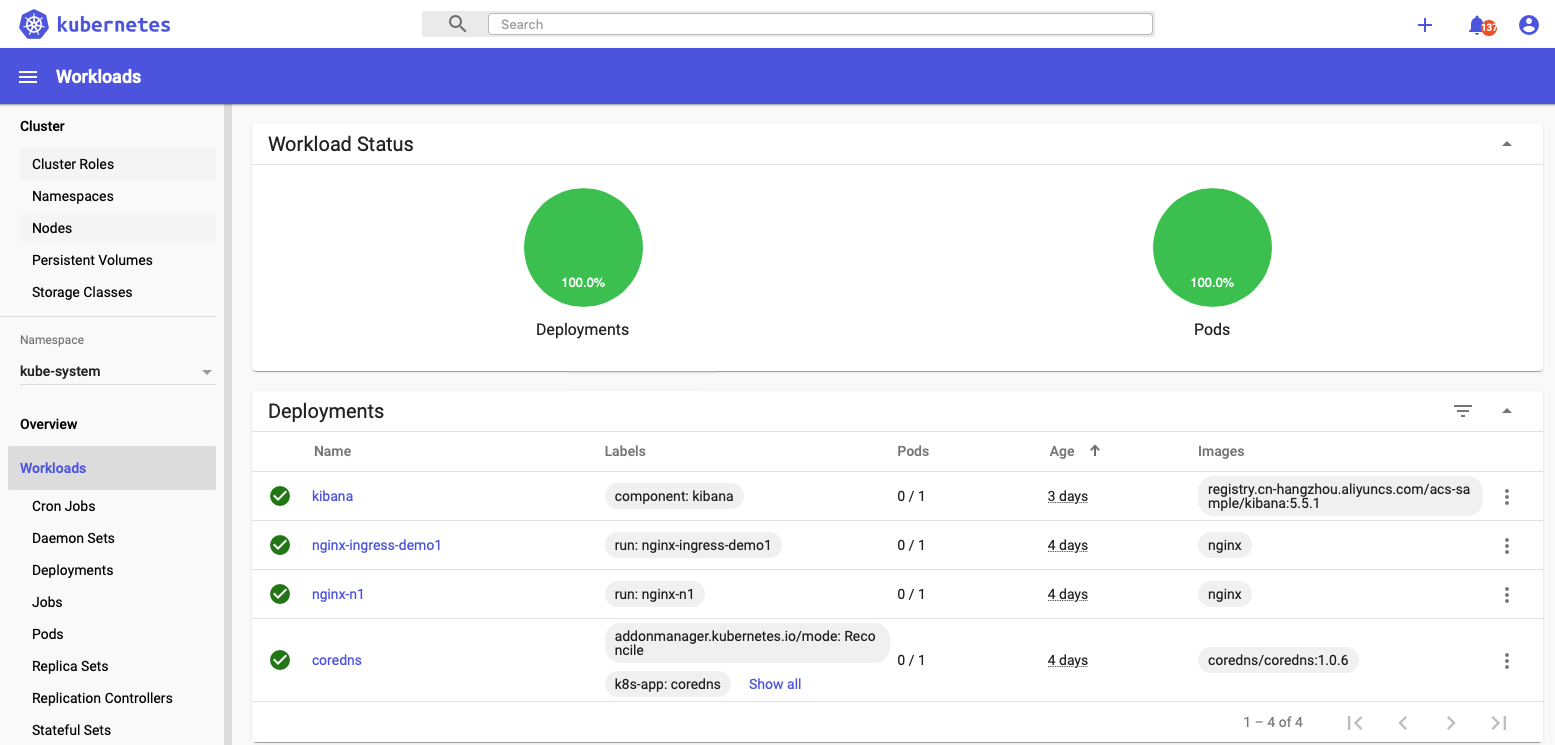
11.9.5 case 2: create an unrestricted SA account for authentication within the cluster
Create SA
[root@master-1 job]# cat super-sa.yaml apiVersion: v1 kind: ServiceAccount metadata: name: super-sa namespace: kube-system
Create account
[root@master-1 rabc]# kubectl apply -f super-sa.yaml serviceaccount/super-sa created
Create ClusterRole (control permissions)
- Use the cluster admin object, which is the built-in ClusterRole object of Kubernetes cluster. There is no need to create it.
View permissions defined by cluster admin
- All resources are unrestricted, equivalent to super administrator
[root@master-1 rabc]# kubectl get clusterrole cluster-admin -o yaml
apiVersion: rbac.authorization.k8s.io/v1
kind: ClusterRole
metadata:
annotations:
rbac.authorization.kubernetes.io/autoupdate: "true"
creationTimestamp: "2020-08-06T07:05:39Z"
labels:
kubernetes.io/bootstrapping: rbac-defaults
name: cluster-admin
resourceVersion: "39"
selfLink: /apis/rbac.authorization.k8s.io/v1/clusterroles/cluster-admin
uid: 8a74bf28-5875-4c66-bcfb-a49dce6d1aa4
rules:
- apiGroups:
- '*'
resources:
- '*'
verbs:
- '*'
- nonResourceURLs:
- '*'
verbs:
- '*'
Create role binding
- The biggest difference between RoleBinding and ClusterRoleBinding is that RoleBinding is limited to NS and ClusterRoleBinding is on the contrary
[root@master-1 job]# cat super-sa-ClusterRoleBinding.yaml
kind: ClusterRoleBinding
apiVersion: rbac.authorization.k8s.io/v1beta1
metadata:
name: super-sa-clusterrolebinding
subjects:
- kind: ServiceAccount
name: super-sa
namespace: kube-system
roleRef:
kind: ClusterRole
name: cluster-admin
apiGroup: rbac.authorization.k8s.io
[root@master-1 rabc]# kubectl apply -f super-sa.yaml serviceaccount/super-sa unchanged [root@master-1 rabc]# kubectl apply -f super-sa-ClusterRoleBinding.yaml clusterrolebinding.rbac.authorization.k8s.io/super-sa-clusterrolebinding created
The base64 code obtained is the same as that in case 1
[root@master-1 ~]# kubectl get secret -n kube-system super-sa-token-wqjz6 kubernetes.io/service-account-token 3 71s
Get token
[root@master-1 rabc]# kubectl get secret super-sa-token-wqjz6 -o jsonpath={.data.token} -n kube-system | base64 -d
eyJhbGciOiJSUzI1NiIsImtpZCI6IiJ9.eyJpc3MiOiJrdWJlcm5ldGVzL3NlcnZpY2VhY2NvdW50Iiwia3ViZXJuZXRlcy5pby9zZXJ2aWNlYWNjb3VudC9uYW1lc3BhY2UiOiJrdWJlLXN5c3RlbSIsImt1YmVybmV0ZXMuaW8vc2VydmljZWFjY291bnQvc2VjcmV0Lm5hbWUiOiJzdXBlci1zYS10b2tlbi13cWp6NiIsImt1YmVybmV0ZXMuaW8vc2VydmljZWFjY291bnQvc2VydmljZS1hY2NvdW50Lm5hbWUiOiJzdXBlci1zYSIsImt1YmVybmV0ZXMuaW8vc2VydmljZWFjY291bnQvc2VydmljZS1hY2NvdW50LnVpZCI6IjI1ZTAzY2QxLTY3N2EtNDAyYy04ZGIzLTVmYjE0NjFkYjA0ZCIsInN1YiI6InN5c3RlbTpzZXJ2aWNlYWNjb3VudDprdWJlLXN5c3RlbTpzdXBlci1zYSJ9.cvBz0uv717Z6OKw3S_ahFxrtF_5CdG-KKOwoQIm7YSZsdKwk0Fovxgf-cKaFILFOb1uKHsbU7Sk2e3VUJx0fdI4ugv6jo53Bi7WO6HPVRoCSxhEoYffzb8GFcRZ0sObPcHqvv35nb572Ll8B-krd3aJ_uUmsPp4QH6LsakXVeQFkAQ-MJBzvX_KcisBqTp87dnvmZJMLbUhsZea0UexGvbwUMR2NLQNelhjJRPfyhlk5TLOpVfycN59BkXtcoD8Ayd8EHWW9T6Dpa1ZXWN-wjJOwl_RT6c1GPARyjOydGIVCAW7sWQAZR-NQmxuWonHyQu-qLjW8e1HhMvn_GE6b3A
Log in to the system using the token generated above
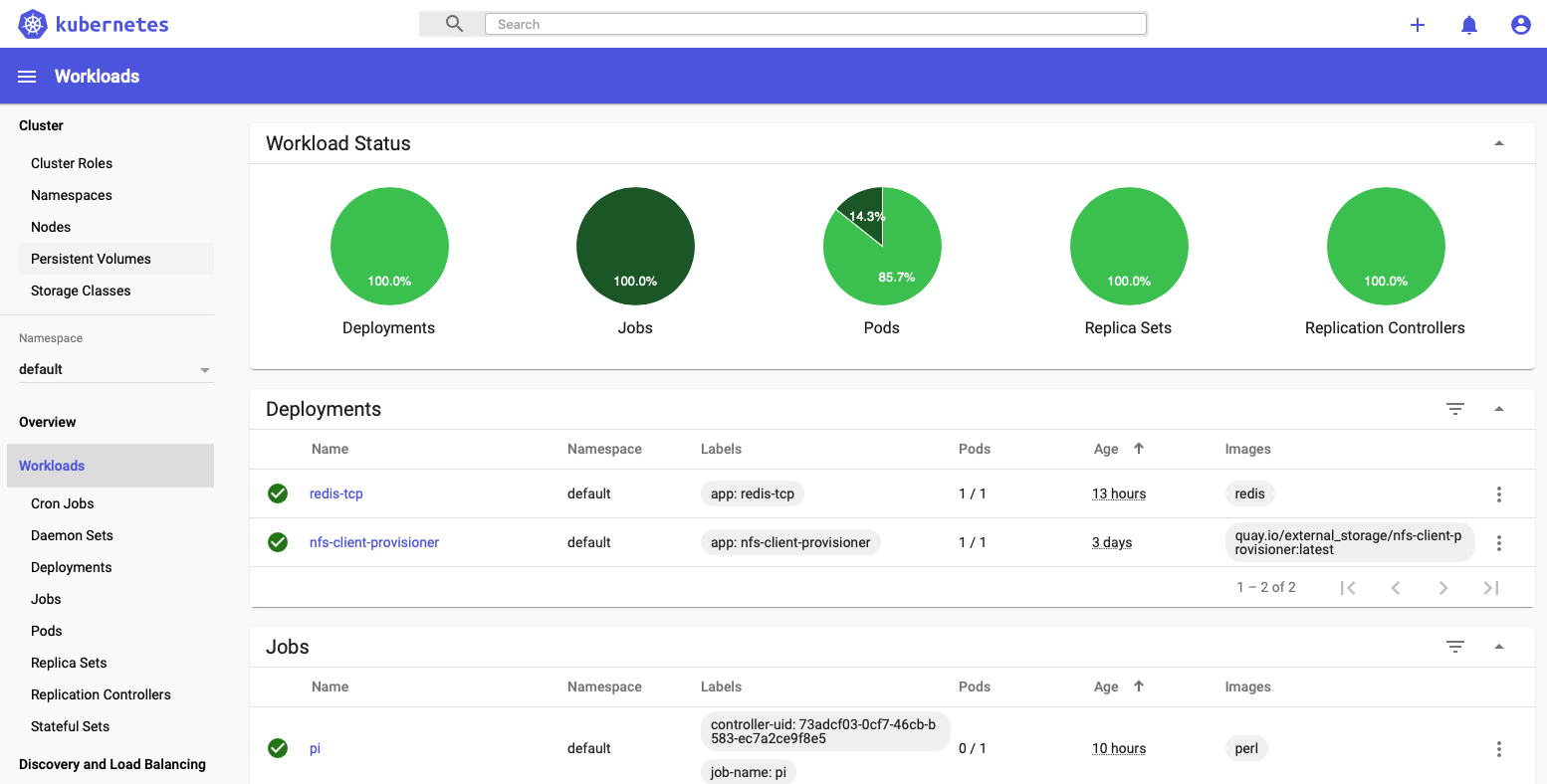
11.9.6 case 3: explanation of Yamal authorization document of RBAC
[root@master-1 job]# cat prometheus-rabc.yaml
apiVersion: rbac.authorization.k8s.io/v1beta1
kind: ClusterRoleBinding
metadata:
name: prometheus-rbac
subjects:
- kind: ServiceAccount
name: prometheus-k8s
namespace: monitoring
roleRef:
kind: ClusterRole
name: cluster-admin
apiGroup: rbac.authorization.k8s.io
11.9.7 case 4: actual operation authorization command operation
kubectl create clusterrolebinding system:anonymous --clusterrole=cluster-admin --user=system:anonymous
explain
- The cluster role is bound to the user system:anonymous and has the permission of cluster admin. The cluster role name is system:anonymous
11.10 Yaml document details
11.10.0 what is yaml?
Yaml is a language for writing configuration files. Structurally, it has two optional types: Lists and Maps.
- List uses - (DASH) to define each item,
- Map is represented by a key value pair of key:value.
11.10.1 YAML syntax rules
- Case sensitive;
- Use indentation to represent hierarchical relationships;
- When indenting, the Tal key is not allowed, and only spaces are allowed;
- The number of indented spaces is not important, as long as the elements of the same level are aligned to the left;
- "#" indicates a comment. From this character to the end of the line, it will be ignored by the parser;
- "-" is an optional separator;
11.10.2 Yaml structure type diagram
In Kubernetes, Yaml supports two structure types: Lists and Maps
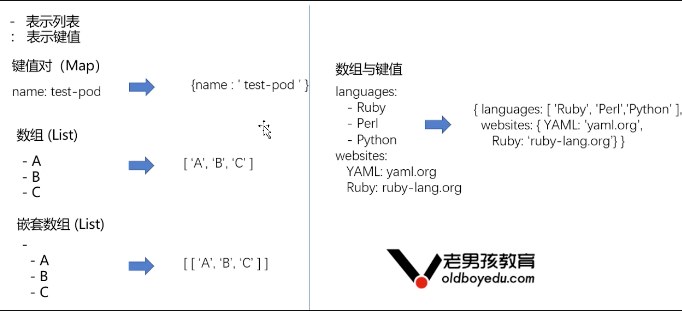
notes
- Yaml to properties( https://www.toyaml.com/index.html )
- Yaml to Jason( http://nodeca.github.io/js-yaml/ )
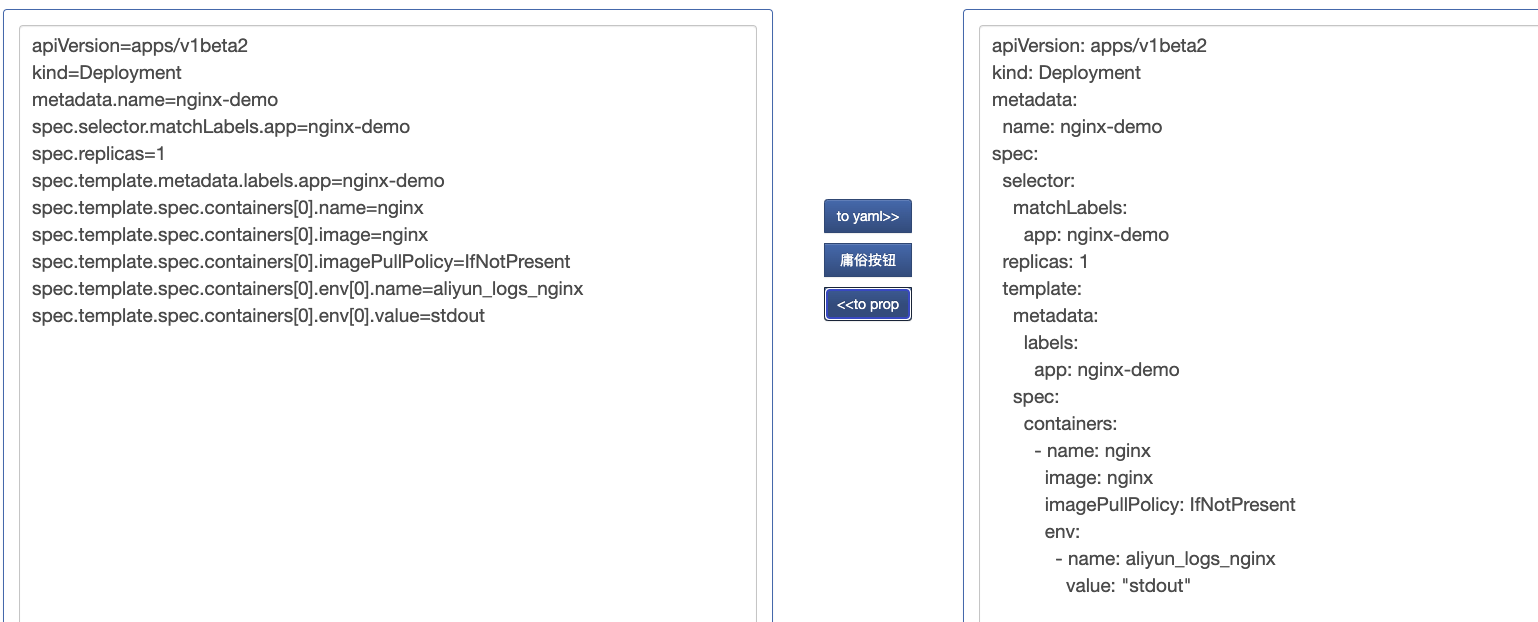
11.10.3 Kubernetes
Create resources through yaml. If you need to create Kubernetes objects through yaml files, you need to configure the following fields:
- apiVersion: the version of the Kubernetes API used to create the object
- kind: the type of object you want to create
- metadata: data that helps identify object uniqueness, including a name string, UID, and optional namespace
11.10.4 case 1: explanation of Kubernetes pod arrangement document
The necessary orchestration file for Pod to run in the program
apiVersion: v1 #Specify the api version. This value must be in kubectl api version
kind: Pod #Specify the role / type to create the resource
metadata: #Metadata / attributes of resources
name: test-pod #The name of the resource must be unique in the same namespace
labels: #Label resources
k8s-app: apache
version: v1
annotations: #Custom annotation list
- name: String #Custom annotation name
spec: #specification of the resource content
restartPolicy: Always #Indicates that the container is always running. The default k8s policy is to create the same container immediately after the container exits
nodeSelector: #For node selection, label the host kubectl label nodes kube-node1 zone=node1
zone: node1
containers:
- name: test-pod #Name of the container
image: 10.192.21.18:5000/test/chat:latest #The mirror address used by the container
imagePullPolicy: Never # Kubernetes pull mirror strategy
command: ['sh'] #Start the running command of the container, which will overwrite the ENTRYPOINT in the container and correspond to the ENTRYPOINT in the Dockefile
args: ["$(str)"] #The command parameter to start the container corresponds to the CMD parameter in Dockerfile
env: #Specifies the environment variables in the container
- name: str #The name of the variable
value: "/etc/run.sh" #Value of variable
resources: #resource management
requests: #When the container is running, the minimum resource requirements, that is, how many resource containers are required to operate normally
cpu: 0.1 #CPU resources (number of cores): floating point number or integer + m, 0.1=100m, and the minimum value is 0.001 core (1m)
memory: 32Mi #Memory usage
limits: #Resource constraints
cpu: 0.5
memory: 1000Mi
ports:
- containerPort: 80 #External port of container development
name: httpd #name
protocol: TCP
livenessProbe: #Setting of pod content health check
httpGet: #Check the health through httpget. If it returns between 200-399, it is considered that the container is normal
path: / #URI address
port: 80
scheme: HTTP
initialDelaySeconds: 180 #Indicates how long after the first test starts after the container is started
timeoutSeconds: 5 #Timeout for detection
periodSeconds: 15 #Inspection interval
#You can also use this method
#exec: the method of executing the command for monitoring. If its exit code is not 0, it is considered that the container is normal
# command:
# - cat
# - /tmp/health
#You can also use this method
#tcpSocket: / / check health through tcpSocket
# port: number
lifecycle: #Life cycle management
postStart: #Tasks run before the container runs
exec:
command:
- 'sh'
- 'yum upgrade -y'
preStop:#Tasks that run before the container closes
exec:
command: ['service httpd stop']
volumeMounts: #Mount persistent storage volumes
- name: volume #The name of the mounted device should correspond to volumes[*].name
mountPath: /data #Mount to a path of the container
readOnly: True
volumes: #Define a set of mounted devices
- name: volume #Define the name of a mounted device
#meptyDir: {}
hostPath:
path: /opt #The mounted device type is hostPath and the path is / opt under the host computer. There are many device types supported here
#nfs
11.10.5 case 2: Kubernetes deployment operation
apiVersion: apps/v1 # Versions before 1.9.0 use apps/v1beta2, which can be viewed through the command kubectl API versions
kind: Deployment #Specify the role / type to create the resource
metadata: #Metadata / attributes of resources
name: web-server #The name of the resource must be unique in the same namespace
spec:
replicas: 2 #Number of pod copies
selector: #Define label selector
matchLabels:
app: web-server #Label of pod meeting the target
template: # This template is used when the Deployment expands the pod
metadata:
labels: #Pod label
app: web-server #The label of the pod copy. The selector selects the pod copy according to this label
spec: #Specify the content of the resource
containers: #Part of pod content container definition
- name: nginx #Name of the container
image: nginx:1.12.1 #Mirror address of the container
ports:
- containerPort: 80 #Container exposed port
[root@master ~]# kubectl create -f nginx.yaml
11.10.6 case 3: operation of Kubernetes Services
[root@master ~]# cat nginx-svc.yaml
apiVersion: v1
kind: Service
metadata:
name: nginx-service #service name
spec:
selector:
app: web-server #pod matching service selector tag
ports:
- protocol: TCP
port: 80 #service port
targetPort: 80 #pod port
11.11 ConfigMap
ConfigMap allows you to separate configuration files from property files to make containerized Applications Portable.
- Kubernetes space can be used;
- It can be used as a variable or path file;
- Pod supports automatic content update;
Get ConfigMap in the system
[root@master-1 configmap]# kubectl get configmap NAME DATA AGE traefik-config 1 4d11h
11.11.1 case 1: configure all key value pairs in ConfigMap as container environment variables
Create a ConfigMap that contains multiple key value pairs.
[root@master-1 configmap]# cat configmap-multikeys.yaml apiVersion: v1 kind: ConfigMap metadata: name: special-config namespace: default data: SPECIAL_LEVEL: L1 SPECIAL_TYPE: Nginx
Create ConfigMap
[root@master-1 configmap]# kubectl apply -f configmap-multikeys.yaml configmap/special-config created
View ConfigMap
[root@master-1 configmap]# kubectl get configmap/special-config -n default NAME DATA AGE special-config 2 31s
View details
[root@master-1 configmap]# kubectl describe configmap special-config
Name: special-config
Namespace: default
Labels: <none>
Annotations: kubectl.kubernetes.io/last-applied-configuration:
{"apiVersion":"v1","data":{"SPECIAL_LEVEL":"L1","SPECIAL_TYPE":"Nginx"},"kind":"ConfigMap","metadata":{"annotations":{},"name":"special-co...
Data
====
SPECIAL_LEVEL:
----
L1
SPECIAL_TYPE:
----
Nginx
Events: <none>
Create container reference ConfigMap
[root@master-1 configmap]# cat pod-configmap.yaml
apiVersion: v1
kind: Pod
metadata:
name: pod-test-configmap
spec:
containers:
- name: pod-test-configmap
image: busybox
command: [ "/bin/sh", "-c", "echo $(SPECIAL_LEVEL_KEY) $(SPECIAL_TYPE_KEY)" ]
env:
- name: SPECIAL_LEVEL_KEY
valueFrom:
configMapKeyRef:
name: special-config
key: SPECIAL_LEVEL
- name: SPECIAL_TYPE_KEY
valueFrom:
configMapKeyRef:
name: special-config
key: SPECIAL_TYPE
restartPolicy: Never
Create pod
[root@master-1 configmap]# kubectl apply -f pod-configmap.yaml pod/pod-test-configmap created
View pod log
[root@master-1 configmap]# kubectl log pod-test-configmap log is DEPRECATED and will be removed in a future version. Use logs instead. L1 Nginx
11.11.2 case 2: adding ConfigMap data to a specific path in the container
Nginx pod file
[root@master-1 configmap]# cat nginx.yaml
apiVersion: apps/v1beta2 # for versions before 1.9.0 use apps/v1beta2
kind: Deployment
metadata:
name: nginx-deployment
spec:
selector:
matchLabels:
app: nginx-configmap
replicas: 1
template:
metadata:
labels:
app: nginx-configmap
spec:
containers:
- name: nginx-configmap
image: nginx
volumeMounts:
- name: config-volume
mountPath: /mnt/
ports:
- containerPort: 80
volumes:
- name: config-volume
configMap:
name: special-config
items:
- key: SPECIAL_LEVEL
path: keys
start-up
[root@master-1 configmap]# kubectl apply -f nginx.yaml deployment.apps/nginx-deployment created [root@master-1 configmap]# kubectl get pod | grep nginx-deployment nginx-deployment-69fd86756f-f6bhw 1/1 Running 0 115s
View container contents
[root@master-1 configmap]# kubectl exec -it nginx-deployment-69fd86756f-f6bhw bash root@nginx-deployment-69fd86756f-f6bhw:/# cd /mnt root@nginx-deployment-69fd86756f-f6bhw:/mnt# ls keys root@nginx-deployment-69fd86756f-f6bhw:/mnt# cat keys L1root
Modify ConfigMap content (verify pod automatic update)
- Modification content
[root@master-1 configmap]# cat configmap-multikeys.yaml apiVersion: v1 kind: ConfigMap metadata: name: special-config namespace: default data: SPECIAL_LEVEL: L111 SPECIAL_TYPE: Nginx
Apply new configuration
[root@master-1 configmap]# kubectl apply -f configmap-multikeys.yaml
configmap/special-config configured
[root@master-1 configmap]# kubectl describe configmap special-config
Name: special-config
Namespace: default
Labels: <none>
Annotations: kubectl.kubernetes.io/last-applied-configuration:
{"apiVersion":"v1","data":{"SPECIAL_LEVEL":"L111","SPECIAL_TYPE":"Nginx"},"kind":"ConfigMap","metadata":{"annotations":{},"name":"special-...
Data
====
SPECIAL_LEVEL:
----
L111
SPECIAL_TYPE:
----
Nginx
Events: <none>
See if the container can be updated automatically
- Wait 1 minute (default)
[root@master-1 configmap]# kubectl exec -it nginx-deployment-69fd86756f-f6bhw -- cat /mnt/keys L111
11.11.3 case 3: configure all key value pairs in ConfigMap as container environment variables
Define profile
- kustomize application configuration management
[root@master-1 redis]# cat kustomization.yaml
configMapGenerator:
- name: redis-master-config
files:
- redis-config
resources:
- redis-pod.yaml
Define redis profile
[root@master-1 redis]# cat redis-config maxmemory 2mb maxmemory-policy allkeys-lru
Define redis pod file
[root@master-1 redis]# cat redis-pod.yaml
apiVersion: v1
kind: Pod
metadata:
name: redis
spec:
hostNetwork: true
containers:
- name: redis
image: redis:5.0.4
command:
- redis-server
- "/redis-master/redis.conf"
env:
- name: MASTER
value: "true"
ports:
- containerPort: 6379
resources:
limits:
cpu: "0.1"
volumeMounts:
- mountPath: /redis-master-data
name: data
- mountPath: /redis-master
name: config
volumes:
- name: data
emptyDir: {}
- name: config
configMap:
name: redis-master-config
items:
- key: redis-config
path: redis.conf
Since the redis TCP pod is created in the inress chapter, port 6379 is occupied. You need to delete the pod
Create redis
[root@master-1 redis]# ll total 12 -rw-r--r-- 1 root root 120 Aug 11 10:33 kustomization.yaml -rw-r--r-- 1 root root 43 Aug 11 10:29 redis-config -rw-r--r-- 1 root root 652 Aug 11 10:31 redis-pod.yaml [root@master-1 redis]# kubectl apply -k . configmap/redis-master-config-k66gtchdm4 unchanged pod/redis created
Get redis node address
[root@master-1 redis]# kubectl get pods -o wide | grep redis redis 1/1 Running 0 6m10s 192.168.91.21 192.168.91.21 <none> <none>
Connect to Redis
[root@master-2 ~]# redis-cli -h 192.168.91.21 -p 6379 192.168.91.21:6379> CONFIG GET maxmemory 1) "maxmemory" 2) "2097152" #byte 192.168.91.21:6379> CONFIG GET maxmemory-policy 1) "maxmemory-policy" 2) "allkeys-lru"